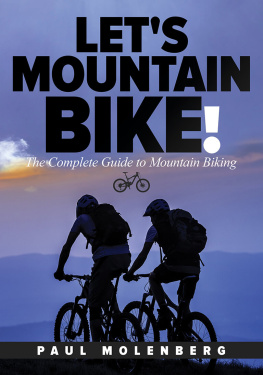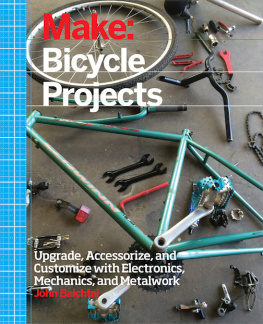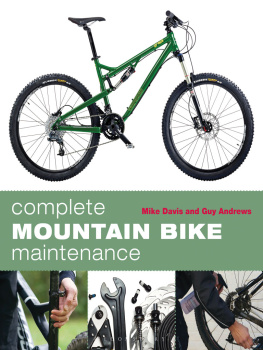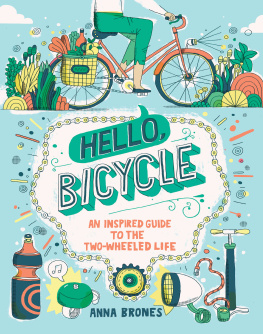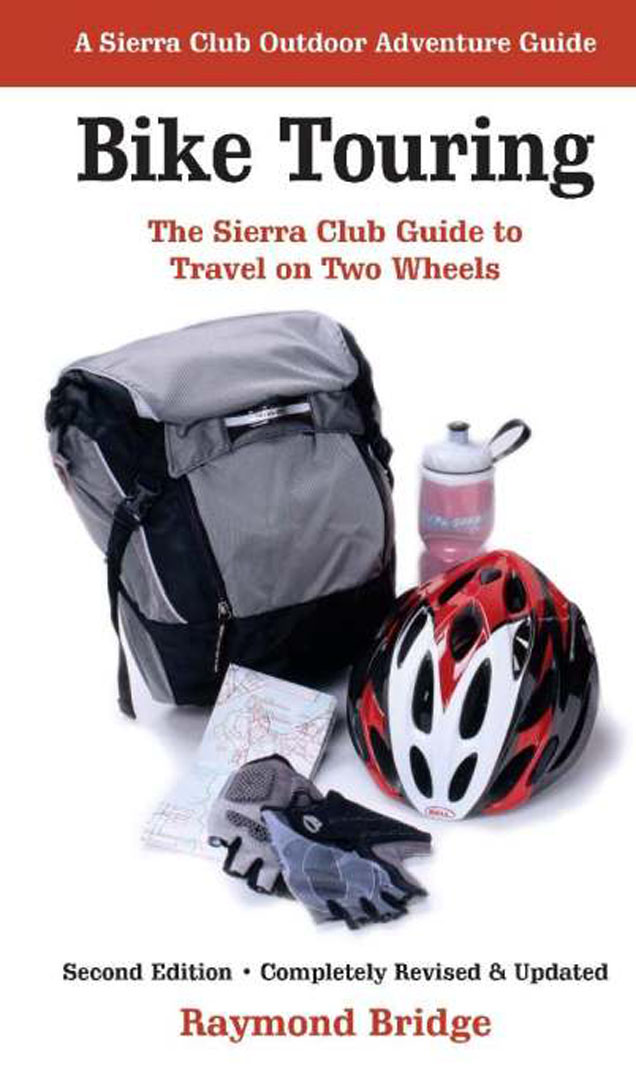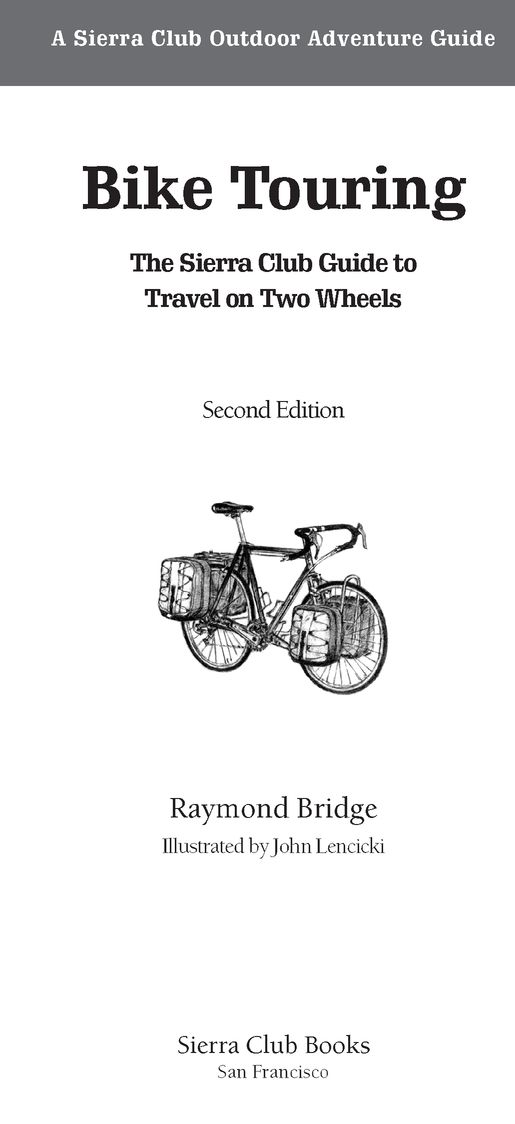Table of Contents
Guide
Table of Contents
Sierra Club Outdoor Adventure Guides
Land Navigation Handbook
The Sierra Club Guide to Map, Compass & GPS
by W. S. Kals
Completely updated, with new text by Clyde Soles
Simple Foods for the Pack
More than 200 all-natural, trail-tested recipes
by Claudia Axcell, Vikki Kinmont Kath, and Diana Cooke
Walking Softly in the Wilderness
The Sierra Club Guide to Backpacking
by John Hart
This book is for
Lucas, Jessica, and Justina
potentially the next generation
of touring cyclists
Preface
It has been three decades since the original edition of Bike Touring was published, and it is interesting to note how much has changed since then and how much remains essentially the same.
This book is completely different from the original, though the approach has hardly changed. There are many more active cyclists today who are interested in bike touring, and good equipment is easier to find and less expensive (adjusted for inflation). However, it is still true that generally unsuitable bicycles are often sold as touring bikes. And there is still a real need for a book that covers the basics for people who want to prepare for long trips exploring the countryside via bicycle.
The changes in this book reflect the evolution of bicycle touring over the last few decades. Most important are the changes in equipment. Increased interest in cycling generally, along with globalization of manufacturing and distribution, has made much better bikes available at reasonable prices. Drive trains even on inexpensive road bicycles today are better, more durable, and easier to maintain than expensive, elite systems of thirty years ago. The same is true of many other components.
Mountain bikes did not even exist at the time the first edition of this book was written. The first custom mountain bike was built around that time. These days more people have mountain bikes than road bikes (though, of course, they mostly ride them in town). Along with many other factors, this has expanded the world of bicycle touring. You can now sign up for a commercially run mountain bike tour in Mexicos Copper Canyon, or put together your own trip on a mountain bike riding from Alaska to Patagonia. Some cyclists prefer to use mountain bikes even for touring mainly on pavement. More important for bicycle touring is that the mountain bike marketing explosion has made many high-quality, low-cost components available for touring.
This book touches on mountain-biking options, but its main topic is tours via paved roads using road bikes, covering the basics you need to know about equipment, skills, and styles of travel. It also contains discussions of tours on trail systems that have sprung up on old towpaths, railroad beds, and similar networks in locations from Missouri to Quebec. It discusses the basics of extended mountain bike tours, but those are not its main emphasis.
This book, like its predecessor, concentrates on the equipment, technique, and training that are important for anyone contemplating multiday trips by bike, on tours that are close to home, that explore some other part of the United States, or that visit some interesting area abroad. However, though the book concentrates on tours you plan yourself, there are many more supported tours available these days, so the book includes some discussion of them. Because mountain bikes provide many interesting touring possibilities for travel away from the pavement, they also get some consideration.
The emphasis in this book, however, is on touring with road bicycles, either staying at motels or hostels while carrying moderate amounts of baggage (sometimes called credit-card touring) or carrying camping gear and other necessities for self-contained touring.
This book assumes that most readers already have some bicycle skills acquired from recreational, commuting, club, or sport riding, so the sections on riding skills and techniques emphasize aspects that are specific to touring or to improving conditioning and training for riders used to either short rides or serious local club riding.
Considerable space is devoted to equipment, even though the equipment is really secondary to the experience of bike touring. In general, the book emphasizes modern, moderately priced road bikes. There are innumerable specialized machines that are prized by some experienced bicycle tourists, ranging from folding bikes to recumbent bicycles, tandems, classic road bikes with components older than their riders, and other fascinating modes of locomotion. Complete discussions of such specialized machines would take us too far afield, so they are mentioned only in passing. For most readers the most suitable touring bike, at least for a time, is one that can be purchased from a shop with only a few modifications. After youve been on a few tours, you will have met riders who have all sorts of opinions about the ultimate touring bike, and youll be able to evaluate their arguments for yourself. You may also have acquired enough enthusiasm for touring that youll be interested in pursuing your own ultimate touring bike.
Oversights, errors, and mistakes in emphasis in this book are strictly my responsibility, but the underlying experience of what works and doesnt in bike touring, as presented here, is the product of the bicycle touring community, a fascinating, knowledgeable, opinionated, and generous group. I am particularly grateful to the Phreds, the Internet bicycle touring discussion group moderated by Alex Wetmore. I am also indebted to my editors at Sierra Club BooksDiana Landau, Edward Wade, Marianne Lipanovich, and Kelly Ryerwho have made this a far better book than it would have been without their discerning eyes.
Introduction
Bicycle touring has much in common with backpacking, kayaking, canoeing, ski touring, and mountaineering. All are forms of self-propelled, lightweight travel that bring the participant into close contact with the natural world, in both its gentle and its harsh moods. There is a special appeal to bicycle touring, however, that makes it unique: the bicycle is a practical means of transportation as well as a recreational vehicle.
The convenience factor in bicycle touring makes it extremely attractive, particularly for those who live in densely populated regions a long way from large tracts of public land. When the closest good backpacking trail is a couple of hundred miles away, a weekend backpacking trip involves a tiresome, time-consuming, and expensive amount of driving, as well as inducing pressure and fatigue because of the tight scheduling needed to mesh the normal work week with the weekends recreation. Especially for those with busy schedules, the logistics of driving from San Francisco to the High Sierra or from Boston to northern New Hampshire are likely to limit the number of such trips to just a few each season.
By contrast, pleasant bicycle tours can begin at most peoples front doors or, at worst, a few miles from home. If you are exploring another part of the United States or a faraway country, you can start your tour from a major transportation terminus instead of dealing with complex travel arrangements to get to the trailhead, river put-in, or shoreline departure point. Thus, if you are traveling from New York to Europe, you can start your bicycle tour from the Frankfurt airport rather than having to take additional transport to the Bernese Oberland before beginning your actual climbing or backpacking trip.


